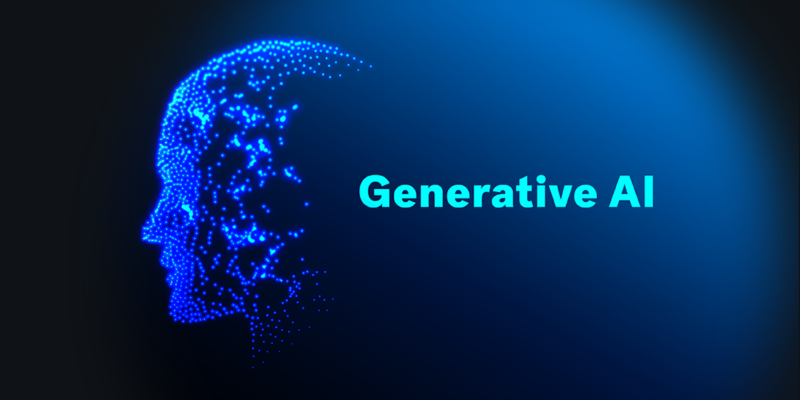Executive Summary:
Welcome to our comprehensive guide on Generative AI, a revolutionary technology shaping the future of artificial intelligence. In this guide, we’ll delve into the workings, applications, and benefits of Generative AI
From art and design to marketing, gaming, healthcare, and education, generative AI is revolutionizing various industries, unlocking new opportunities for innovation and efficiency.
Introduction
Generative AI refers to algorithms that generate new content, such as images, text, or audio, mimicking human creativity. These models learn patterns from vast datasets and use them to create novel outputs.
How Does Generative AI Work?
Generative AI, particularly in the context of Natural Language Processing (NLP), utilizes sophisticated machine learning models to generate new content that mimics human language. One notable example of such a model is the Large Language Model (LLM), which encompasses advanced techniques in NLP and generative AI. Let’s delve deeper into how these components work:

Generative AI and Large Language Models (LLMs):
LLMs are deep learning models trained on massive text datasets, ranging from books and articles to social media posts and website content. These models learn to understand and generate text by analyzing patterns and relationships within the data.
- Architecture: LLMs typically employ transformer-based architectures, such as OpenAI’s GPT (Generative Pre-trained Transformer) series or Google’s BERT (Bidirectional Encoder Representations from Transformers). These architectures consist of multiple layers of self-attention mechanisms and feedforward neural networks, enabling them to capture long-range dependencies and contextual information in text.
- Training Process: LLMs are pre-trained on large corpora of text data using unsupervised learning techniques. During pre-training, the model learns to predict the next word in a sequence given the preceding context. This process helps the model better understand language syntax, semantics, and structure.
- Fine-tuning: After pre-training, LLMs can be fine-tuned on specific tasks or domains using supervised learning methods. Fine-tuning involves adjusting the model’s parameters on a smaller labeled dataset relevant to the target task, such as text generation, sentiment analysis, or language translation. This process allows LLMs to adapt to specific contexts and generate more accurate and contextually relevant outputs.
Generative AI in NLP:
Generative AI in NLP refers to using machine learning models to generate human-like text based on input prompts or conditions. These models leverage probabilistic sampling techniques to produce diverse and contextually coherent text outputs.
- Sampling Methods: Models employ various sampling strategies to generate text. These include greedy decoding, beam search, nucleus sampling (top-k sampling), and temperature scaling, each with its trade-offs in terms of output quality, diversity, and coherence.
- Conditional Generation: Generative AI models can perform conditional text generation, where the generated output is conditioned on specific input prompts or constraints. This allows users to control the style, tone, topic, or context of the generated text by providing relevant conditioning information to the model.
- Evaluation Metrics: Evaluating the quality of generated text is essential in generative AI. Common evaluation metrics include perplexity, BLEU (Bilingual Evaluation Understudy), ROUGE (Recall-Oriented Understudy for Gisting Evaluation), and human judgment through manual assessment or crowdsourcing.
Technical Aspects:
The technical aspects of LLMs, generative AI, and NLP involve a combination of deep learning, probabilistic modeling, and linguistic analysis techniques. These include:
- Neural Network Architectures: Transformer-based architectures, attention mechanisms, and recurrent neural networks (RNNs) are fundamental components of LLMs and generative AI models.
- Loss Functions: Training LLMs and generative AI models involves minimizing a loss function, such as cross-entropy loss or perplexity, which measures the discrepancy between predicted and actual text sequences.
- Tokenization: Text data is tokenized into discrete units, such as words or subwords, to represent input sequences in a numerical format suitable for processing by neural networks.
- Attention Mechanisms: Attention mechanisms allow LLMs to focus on relevant parts of the input text when generating output, facilitating long-range dependencies and context modeling.
Prominent Generative AI Models and Their Functions:
Chat GPT (Generative Pre-trained Transformer): Developed by OpenAI, GPT is a series of generative language models based on transformer architectures. These models are trained on vast amounts of text data and can generate coherent and contextually relevant text given a prompt. Example applications include text completion, language translation, and content generation for chatbots.
DALL-E: Also developed by OpenAI, DALL-E is a generative AI model specifically designed for image generation from textual descriptions. Given a textual prompt describing an image, DALL-E can generate novel and realistic images that match the description. This model has applications in art generation, visual storytelling, and product design.
BERT (Bidirectional Encoder Representations from Transformers): Developed by Google, BERT is a language representation model trained on large text corpora using unsupervised learning techniques. While BERT is primarily a pre-trained language model for natural language understanding tasks, it can also be fine-tuned for generative tasks such as text summarization and question answering.
CLIP (Contrastive Language–Image Pretraining): Developed by OpenAI, CLIP is a multimodal model trained to understand the relationship between images and text. CLIP can generate textual descriptions of images and vice versa, enabling tasks such as image captioning, image-to-text generation, and text-to-image generation.
StyleGAN (Style Generative Adversarial Network): Developed by NVIDIA, StyleGAN is a generative adversarial network (GAN) architecture designed for high-fidelity image generation. StyleGAN can generate photorealistic images with controllable features such as facial expressions, hairstyles, and clothing styles. This model is widely used in art generation, fashion design, and visual effects.
Use Cases For Generative AI, By Industry
Marketing and Advertising: Generative AI is used in marketing and advertising to personalize content, create targeted ads, and generate engaging visuals. It can analyze consumer data to tailor marketing campaigns, automate content creation for social media, and generate personalized product recommendations.
Gaming: Generative AI is employed in the gaming industry for procedural content generation, character and world design, and creating dynamic and immersive gaming experiences. It can generate game levels, landscapes, characters, and storylines based on predefined rules and player interactions.
Fashion: In the fashion industry, generative AI is used for virtual try-on experiences, fashion design and customization, and trend forecasting. It can generate virtual clothing designs, simulate fabric textures and patterns, and personalize fashion recommendations based on individual preferences.
Healthcare: Generative AI has applications in healthcare for medical image analysis, drug discovery, and patient data analysis. It can generate synthetic medical images for training and testing diagnostic algorithms, design new drug compounds, and assist in personalized treatment planning.
Education: Generative AI is utilized in education for creating interactive learning materials, generating educational content, and personalizing learning experiences. It can generate quizzes, exercises, and simulations tailored to individual student needs, facilitating adaptive learning and knowledge retention.
Benefits of Using Generative AI
Generative AI offers several benefits:
Creativity: Models can produce novel and imaginative content, ranging from text and images to music and art, allowing for the exploration of new ideas and creative possibilities.
Automation of Content Generation Tasks: Generative AI automates the process of creating content, reducing the need for manual intervention and speeding up production workflows. This efficiency can save time and resources for individuals and organizations.
Augmentation of Limited Datasets: Generative AI can generate synthetic data to augment limited datasets, improving the robustness and diversity of machine learning models. This approach helps mitigate data scarcity issues and enhances model performance in various tasks.
Exploration of New Design Possibilities: Generative AI facilitates the exploration of new design concepts and variations by generating a wide range of outputs based on input parameters or constraints. This capability enables designers and creators to experiment with different styles, configurations, and configurations, fostering innovation and creativity.
What Is The Difference Between AI And Generative AI?
Generative AI specifically focuses on creating new content, such as images, text, or music, that resembles human-generated data.
It involves training models to understand patterns in existing data and generate new samples that follow similar patterns. Generative AI is often used for creative tasks like art generation, text generation, and content creation.
On the other hand, AI (Artificial Intelligence) is a broader field that encompasses various techniques and methodologies aimed at creating machines capable of performing tasks that typically require human intelligence.
This includes not only generative tasks but also tasks such as problem-solving, decision-making, pattern recognition, and more. AI encompasses a wide range of technologies, including machine learning, deep learning, natural language processing, computer vision, and robotics, among others.
Conclusion:
In conclusion, By adhering to best practices we can harness the full potential of generative AI while mitigating risks and ensuring positive societal impact.
Looking ahead, the future of AI holds promise for further advancements in creativity, human-AI collaboration, personalized content generation, and ethical considerations. As AI continues to evolve, it will play an increasingly significant role in shaping the way we create, communicate, and interact with technology and each other.

Dawood is a digital marketing pro and AI/ML enthusiast. His blogs on Folio3 AI are a blend of marketing and tech brilliance. Dawood’s knack for making AI engaging for users sets his content apart, offering a unique and insightful take on the dynamic intersection of marketing and cutting-edge technology.









